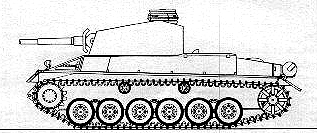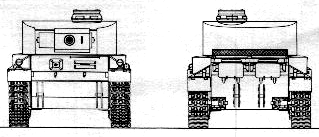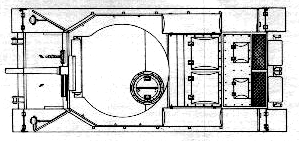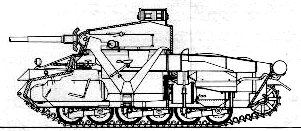
Drawing by H. L. Doyle
Porsche Type 100, VK 3001(P)
"Leopard"
Drawing by H. L. Doyle
In 1939, the German army indicated the need for a
tank in the 30-ton weight class. This led to the development of
several VK 3001 projects by four competing manufacturers: Porsche KG,
Henschel and Sohn, Maschinenfabrik Augsburg-Nuernberg (MAN), and
Diamler-Benz. The competing designs were designated by a letter
following the prototype code. Therefore, the Porsche entry into
the VK 3001 competition was referred to as VK 3001(P).
The technical data for the Leopard is as follows:
| VK 3001(P) "Leopard" | |
|---|---|
| Crew: 5 | Armament: one 7.5cm KwK L/24 (or one 10.5cm KwK L/28) + one 7.92mm MG34 |
| Weight: 30 tons | Traverse: 360o (electric) |
| Length: 6.58 meters | Elevation: -10o +20o |
| Width: 3.8 meters | Engine: Two Porsche Typ-100 petrol |
| Height: 3.05 meters | Gearbox: Electric drive (powered by petrol engines) |
| Radio: FuG5 | Speed: 60 km/hr |
Front and Rear Views
Drawing by H. L. Doyle
Top View
Drawing by H. L. Doyle
Interior View
Drawing by H. L. Doyle
The vehicle had 75 to 80mm armor on all front surfaces.
Side armor was universally 60mm, while rear armor varied from 40 to 60mm.
The project was abandoned in 1941 when the armament criteria
changed. The army at that point wished to mount the 8.8cm gun in
any tank heavier than the Panzer IV which the turret of the VK 3001(P)
could not accept this gun (nor could any other VK 3001). The only flaw
discovered in the design was the unreliability of the gasoline
engines. Experience gained by Porsche with the development of the
VK 3001 was used in the development of the VK 4501(P). This vehicle
was one of the two prototypes entered in the competition which resulted
in the Tiger I tank.